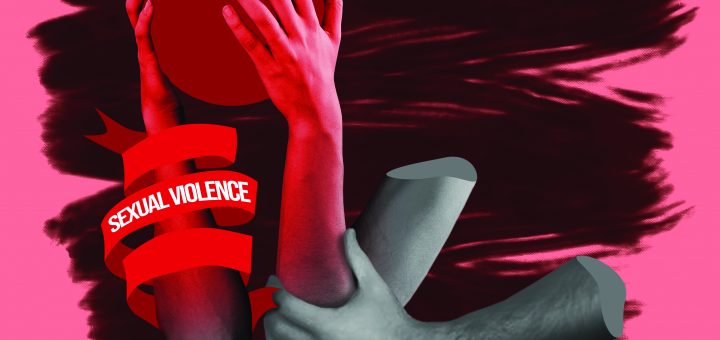Aftermath: Breaking through the uncomfortable conversations

By Riggs Zyrille Vergara, Staff Writer
In the 2015 study of Women’s Media Center on how the U.S. media covers campus rape and sexual assault, they found that 41 per cent of the topics given focus in these stories are rape proceedings and only 12 per cent are on the impact of the event on victims and perpetrators. They also found that it’s rare for the public to read whether the self-identified victim suffered mental health issues or a loss of social status because of the event.
In response to the need of giving more focus on the well-being of the survivors rather than just the personalities involved or the circumstances surrounding the incident, The Reflector initiated “Aftermath: Sexual Violence” — a three-part series shedding light on the importance of the outcomes of sexual violence for the survivor.
This is part-two of the series. To read part one, click here
Sarah Whitney, one of the featured public speakers at Rape, Abuse & Incest National Network’s (RAINN) “20 Years: 20 Voices” campaign about sexual violence, was sexually assaulted by a stranger when she was 16. The first person she told about it was her boyfriend who blamed her and broke up with her on the spot. After a year of experiencing depression and anxiety, she attempted suicide. Only then she had the courage to tell her family — through a nurse — about her experience.
“He was the closest person to me at the time, so I thought if he didn’t believe me, no one would,” Whitney added in her story at RAINN’s campaign.
Whitney is one of the estimated two-thirds of all sexual violence survivors who disclose their experience to at least one person. Along with that number, Courtney Ahrens, member of the psychology department faculty of California State University, reported in her article, featured in the American Journal of Community Psychology, that when survivors are exposed to victim-blaming behaviours or attitudes, the experience may feel like a “second assault,” a phenomenon known as “secondary victimization.”
Through the the global rise of the #MeToo movement last Oct. 2017, the average number of police-reported sexual assault cases went from 59 to 74 per day, according to a Statistics Canada report published in Nov. 2018. Sexual violence survivors are breaking through uncomfortable conversations to get their message across and get the support they deserve. But with the lack of proper responses from would-be supporters, many of them might go back into hiding. So how do we respond to them?
Listen and believe
When asked what’s the first thing anyone should do when someone disclosed to them, Cari Ionson, MRU’s sexual violence and awareness response coordinator, said “Believe them. I can’t say that enough. Make sure they feel that there could be no way it’s their fault.”
In a culture that propagates the myth that those who report sexual violence are liars, statements like “I believe you” and “It’s not your fault” can go a long way for survivors. As they have higher feelings of distrust and hesitation, this can prompt them to be more comfortable in the conversation. When we acknowledge these biases on the culture surrounding sexual violence, we can be more aware of how our statements impact survivors close to us.
Often when Ionson meets parents of survivors, she noted, she always receives questions around why their child was breaking curfew or drunk at a party or why were they participating in any kind of rule-breaking activity. These questions might seem to have good intent, but what it suggests is by choosing to break that rule, the survivor established an opportunity to be sexually violated. We need to understand that there are consequences to rule-breaking and other unsafe actions, but it should not be sexual violence.
Another myth around sexual violence is how perpetrators are characterized as some stranger hidden in a dark alley waiting for their next victim. But according to Southern Alberta Housing Association, in 82 per cent of sexual violence incidents, the victim knows the perpetrator. Within this myth is the struggle for someone to believe that their friend or relative has sexually assaulted someone else. But when we immediately make statements like “I can’t believe that’s something they could’ve done” or “Are you sure it’s actually them?” it can suggest disbelief and distrust to the survivor’s story.
Bringing back control
One of the things Ionson emphasized is that sexual violence constitutes a loss of power and control. The ability to choose is taken away from the survivor. So, a part of their healing becomes bringing back their control. This could come in the form of asking them how they want to heal. “How can I support you?”, “Do you want to talk about it?” and “What can make you comfortable right now?” are questions we can ask them.
There might also be times when we feel like giving them advice on what they should’ve done during the incident is the most helpful thing to do. But as Tarhata Brazsal, another one of RAINN’s campaign speakers, had said “Offer yourself to be part of their healing process but do it on their timeline.” The actions that we think must have been effective in our own crisis, can look different when done on someone else’s traumatic experiences.
Knowing the resources
As much as we want to be always present for the survivor, we as supporters have our limits. One way to mitigate this is to have a good network of help. This includes knowing the nearest points of support within the community, may it be in the school or in the neighbourhood.
But this kind of help doesn’t stop in merely “pointing out” the options for them. It can look like making the call or going with them to the place of support. At MRU, Ionson offers help in the office of Campus Equity & Meaningful Inclusion, where she guides students into other points of support within and outside the campus. Within the first 96 hours of the incidence of sexual violence, the Sheldon M. Chumir Health Centre’s Sexual Assault Response Team can be the nearest available place someone can go to.
A culture of care
In our culture where, unfortunately, there is a high prevalence of sexual violence, it has become an important mission to eradicate the surrounding victim-blaming behaviours as much as it’s important to prevent sexual violence itself. The best way to do it is finding ways to talk about sexual violence, no matter how uncomfortable it can become. As Ionson had said, “The more we create a supportive environment for [sexual violence survivors], the less supportive environments become for people who choose to use violence.”





